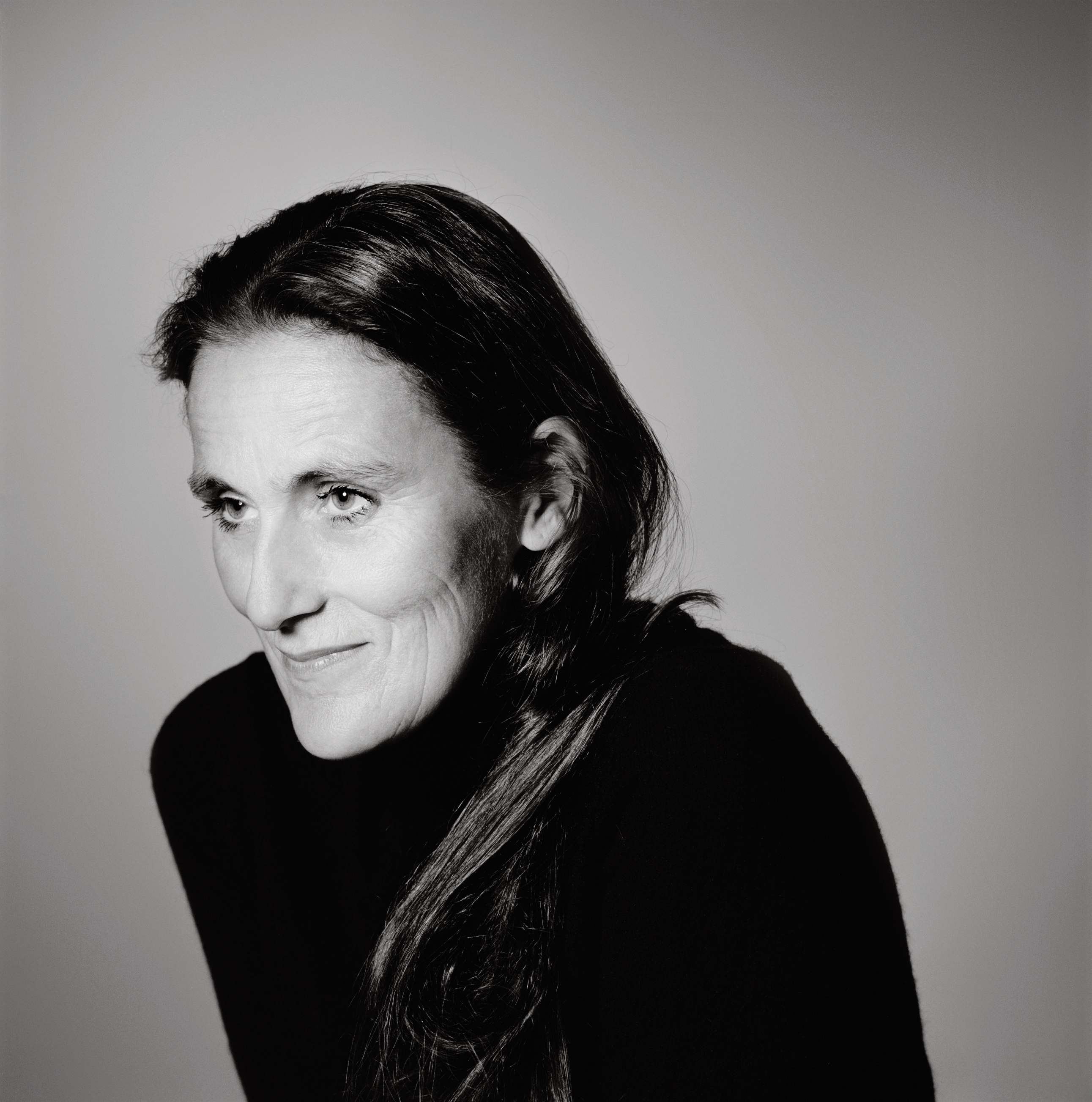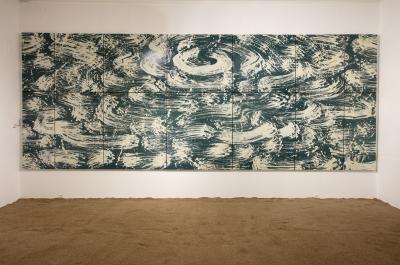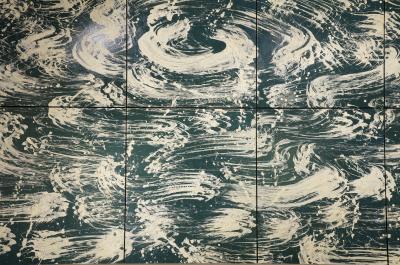J. Fabienne Verdier
"Jeux d’eau au jardin, 2021"

Guided by Chinese painting traditions and an intensely sensitive vision of the murmur of the world, since the end of the 1980s Fabienne Verdier’s work has ceaselessly explored the universe of elementary forms and has given shape to a multitude of relationships that, once revealed, are as clear as they are unheard of, between the physical and the spiritual, the individual and the universal, the inner being and inhabited nature. Springing forth from mature consideration, her paintings are as much “images of thought” as condensed slivers of what can be seen. Each brushstroke in the artist’s ascetically simple paintings is dictated by minute observation, infinitely careful listening, and a meditation on the singular vibration of each moment of the world. The perception of cosmic unity can only be achieved by shedding one’s own perspective and sense of self, thanks to which the artist’s work offers the spectator the same chance to embark on this transformative pathway.
The painting on display at the Domain of Chaumont-sur-Loire was originally called “The Toad’s Leap”, a title that was discarded because of the anecdotal character it seemed to confer upon the work, but which still illuminates what we see on the canvas. The painting bears the transformed marks of this imagined event, a myriad of circles spinning in dizzying whirlpools which seem to signify, more than just memory, a universal passage through the cosmic dimension. Vortex, the Latin word for “whirlpool”, displays a linguistic nearness to the word for “voice”, according to “L’experience du langage” jointly written by Alain Rey and Fabienne Verdier for the Petit Robert in 2017. “A twist of fire over the blue silence, the human voice. A faint trail leads to it, a breath, a sigh, a gust. […] Source of song and word, servant of thought, dispenser of emotion, ally and adversary of reason, the vocal sound is a plunge, a vortex, a whirlpool of being”, wrote the great linguist before his passing in October 2020.
What do these whirlpools tell us? How can we open up or show their voice? The river which originally inspired the work is the one which runs next to the artist’s Hédouville-based home studio in the Vexin region of the Val-d’Oise. Here in the Agnès Varda Courtyard, the whirlpools seem to provide a painted response to those which rush and spin in the Loire just below the Domain. From the bridge linking Onzain and Chaumont, we can see similar eddies created by the build-up of sediment and stones beneath the surface, their bubbles adding a bit of excitement to a leisurely rafting expedition. Upon contemplation, they seem to echo the words of Alain Rey that “immobile forms are never at rest, they move and ‘travel’ spiritually […] embracing anything shaped or even shapeless, the world of signs, of ideal materiality, of concrete idealness, which knows how to give birth to meaning, project it, make it live and travel” (Le Voyage des formes: l’art, matière et magie, 2014).
“My intuition tells me that there is a shared topography between the human body’s interior movements and the body of the world, the fluidity of blood and that of waterfalls or rivers. […] I call on the spectator’s eye to travel over the canvas just like I do, and I want them to be sensitive to the energy in motion that I try to capture, even inviting it to come out of the picture frame! Maybe that is why I destroy any of my paintings that don’t seem right and that don’t provide the others with enough breathing room. I keep only what opens and what is incarnate”, states Fabienne Verdier (La Croix L’Hebdo, 30 June 2020). Far from being foreign to us, the toad’s leap can open a window to our soul. The whirlpool it creates is an opportunity for a metaphysical, poetic experience.
“Let us consider the singularity of the whirlpool”, suggests the philosopher Giorgio Agamben, “It is a shape that has separated from the flow of water it once was a part of, and to which in a certain way it still belongs; a sovereign region enclosed in itself, obeying its own laws; and yet it is tightly bound to all that in which it is immersed, made of the same substance as the surrounding liquid mass with which it is in constant exchange. It is a being in and of itself and yet there is not one drop that belongs to it, its identity is totally immaterial.” According to the philosopher, this natural phenomenon can help us learn about and imagine ourselves and our position in life: “The subject should not be considered a substance but rather a whirlpool in the flow of being. It has no other substance than that of the individual being, but with regard to the latter, it does have its own shape, matter, and movement.” (Le feu et le récit, 2014). Echoes within echoes, these whirlpools in water and in painting lead us to our proper place in the living tissue of the world. They join the chorus of Gérard de Nerval’s “Golden Verses”: “Everything is intelligent!” – And everything moves you.” (Les Chimères, 1854).
BIOGRAPHICAL NOTES


Fabienne Verdier was born in France in 1962. Since completing her studies in fine arts school, her artistic career has been marked by her confrontation of thought systems from different cultures and time periods.
Her creative process is fed by a hybridised knowledge that shows itself through the use of various technical inventions (oversized brushes, glaze mixing and film sketches). After her fine arts school studies, she continued her education with painting masters in China from 1983 to 1992. She then spent many years immersed in the work of the Expressionist abstract painters to create a series of paintings for the Fondation H. Looser in Zurich. Between 2009 and 2013, she took on the paintings of the Flemish Primitives (Van Eyck, Memling and Van der Weyden) to create an exhibition for the Groeninge Museum in Bruges. In 2014, she set up a studio at the Julliard School in New York for the institution’s first ever research laboratory on sound and image waves. From 2015 to 2017, she collaborated with Alain Rey on the fiftieth edition of the Petit Robert, creating 22 paintings in celebration of the creative energy of language. In 2019, the Musée Granet in Aix-en-Provence showcased the artist with a retrospective exhibition covering her career since her return from China up to her latest works depicting the Bibémus quarries next to Montagne Sainte-Victoire. The same year, one of her paintings was chosen out of a twelve-work series to feature on a new stamp for the French postal service.
Fabienne Verdier is represented by Galerie Lelong & Co. (Paris and New York).


